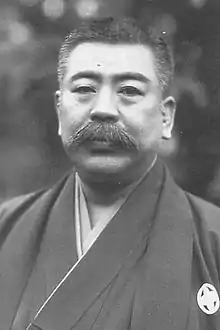Seiji Noma | |
|---|---|
 | |
| Born | 1878 |
| Died | 1938 (aged 59–60) |
| Occupation | Journalist |
| Known for | founder of Kodansha |
Seiji Noma (野間 清治, 1878–1938) was a Japanese writer and publisher who was the founder of Kodansha, a leading publishing company. He was the founder and publisher of many well-known newspapers and magazines.
Early life and education
Noma was born in 1878.[1][2] His father hailed from a samurai family and was himself a samurai.[3]
Noma was educated as a teacher.[1]
Career
Following his graduation Noma worked as a teacher in the Luchu Islands.[1] Later he served as a schoolmaster.[3] Then he began to work as an administrative official at the Imperial University's law department in Tokyo.[3]
Noma established a publishing company, Dainihon Yūbenkai (Japanese: the Great Japanese Oratorical Society), in 1910.[1] The company would be later renamed as Kodansha.[4] The first publication of the company was Yūben, a monthly magazine on public speech.[3][4]
The nine magazines Noma started enjoyed high levels of circulations and were very influential on the popular culture of Japan.[5] His goal in starting these titles was to modernize, entertain and educate Japanese society.[3] On the other hand, they comprised the 75% of the total circulation of all Japanese publications.[6] These publications included Kodan Club, Shōnen Club, Omoshiro Club, Gendai (Japanese: Present Generation), Fujin Club, Shōjo Club and Kingu.[1] The latter was his flagship magazine which was identified with the company.[7] In 1930 he established Hochi Shimbun (Japanese: Intelligence Newspaper) which also became an influential publication.[1]
Personal life and death
Noma's wife was a teacher.[2] He died of heart attack in Tokyo on 18 October 1938.[8]
See also
References
- 1 2 3 4 5 6 "Books: Clubby Magazines". Time. 10 September 1934. Retrieved 26 May 2022.
- 1 2 "Vox Populi: Bank of Japan is overstepping with new climate change program". The Asahi Shimbun. 19 July 2021. Retrieved 26 May 2022.
- 1 2 3 4 5 Catherine Yoonah Bae (2008). All the girl's a stage: Representations of femininity and adolescence in Japanese girls' magazines, 1930s–1960s (PhD thesis). Stanford University. p. 35. ISBN 978-0-549-62286-4. ProQuest 304468205.
- 1 2 Junya Morooka (2014). "Historical Inquiry Into Debate Education In Early 20th Century Japan: The Case of Intercollegiate Debates In Yūben". Rozenberg Quarterly.
- ↑ Joy Poulson (2019). "Women in Media". In Joyce C Lebra; et al. (eds.). Women In Changing Japan. New York; Abingdon: Routledge. p. 200. ISBN 978-1-000-01107-4.
- ↑ S. Takahashi (1946). "The Magazines of Japan" (PDF). EVols. 13 (1): 55.
- ↑ Amy Bliss Marshall (2019). Magazines and the Making of Mass Culture in Japan. Toronto: University of Toronto Press. p. 58. ISBN 978-1-4875-0286-7.
- ↑ "Seiji Noma, Writer, Japanese Publisher; Owner of Newspaper Hochi Also Developed Magazines". The New York Times. 18 October 1938. Retrieved 26 May 2022.
External links
 Media related to Seiji Noma at Wikimedia Commons
Media related to Seiji Noma at Wikimedia Commons